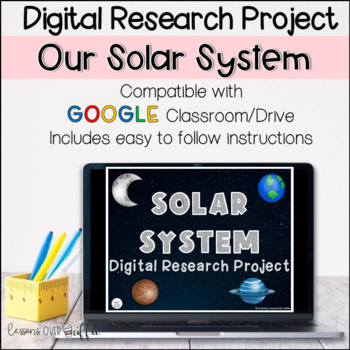Interactive Solar System Digital Research Project
Christine's Lessons Over Coffee
455 Followers
Grade Levels
3rd - 5th, Homeschool
Subjects
Resource Type
Standards
CCSSRI.3.3
CCSSRI.3.7
CCSSRI.4.3
CCSSRI.4.7
CCSSRI.4.9
Formats Included
- Google Drive™ folder
- Internet Activities
Pages
14 pages
Christine's Lessons Over Coffee
455 Followers

Made for Google Drive™
This resource can be used by students on Google Drive or Google Classroom. To access this resource, you’ll need to allow TPT to add it to your Google Drive. See our FAQ and Privacy Policy for more information.
Description
Extend students learning by assigning an interactive digital research project focused on the Solar System!
Click Here to See the Project in Action
This resource contains embedded videos about the Solar System and clickable research links. Students will use provided links to research the planets in our Solar System and identify why Pluto is no longer considered a planet.
Included in this resource:
- The students will be provided with an introduction about the Solar System
- One embedded video about the Solar System
- A page with moveable pieces, students will be asked to place the planets in order
- A page with clickable research links
- Instructions for adding this assignment to Google Classroom
Terms of use: This resource is intended for single classroom use. Additional licenses may be purchased for multiple classrooms.
Total Pages
14 pages
Answer Key
N/A
Teaching Duration
N/A
Report this resource to TPT
Reported resources will be reviewed by our team. Report this resource to let us know if this resource violates TPT’s content guidelines.
Standards
to see state-specific standards (only available in the US).
CCSSRI.3.3
Describe the relationship between a series of historical events, scientific ideas or concepts, or steps in technical procedures in a text, using language that pertains to time, sequence, and cause/effect.
CCSSRI.3.7
Use information gained from illustrations (e.g., maps, photographs) and the words in a text to demonstrate understanding of the text (e.g., where, when, why, and how key events occur).
CCSSRI.4.3
Explain events, procedures, ideas, or concepts in a historical, scientific, or technical text, including what happened and why, based on specific information in the text.
CCSSRI.4.7
Interpret information presented visually, orally, or quantitatively (e.g., in charts, graphs, diagrams, time lines, animations, or interactive elements on Web pages) and explain how the information contributes to an understanding of the text in which it appears.
CCSSRI.4.9
Integrate information from two texts on the same topic in order to write or speak about the subject knowledgeably.



